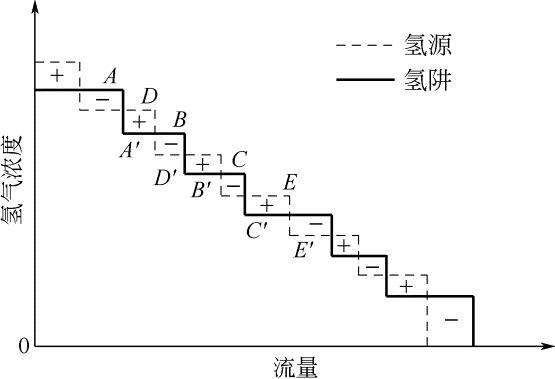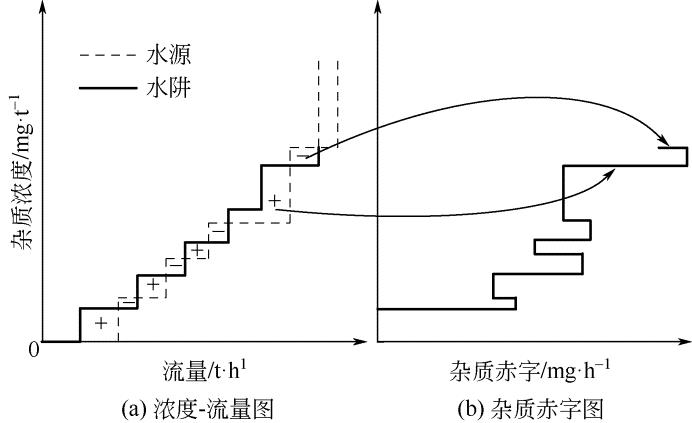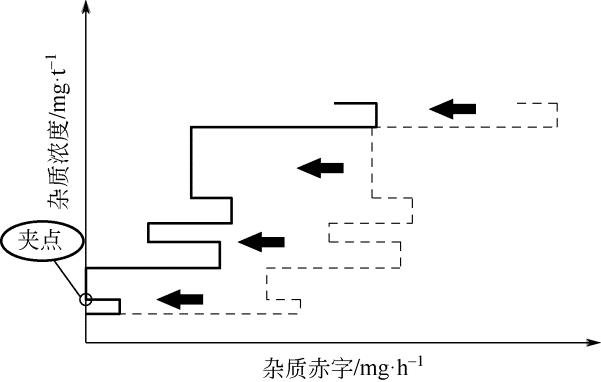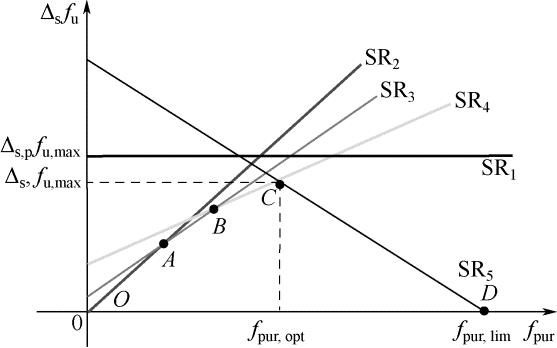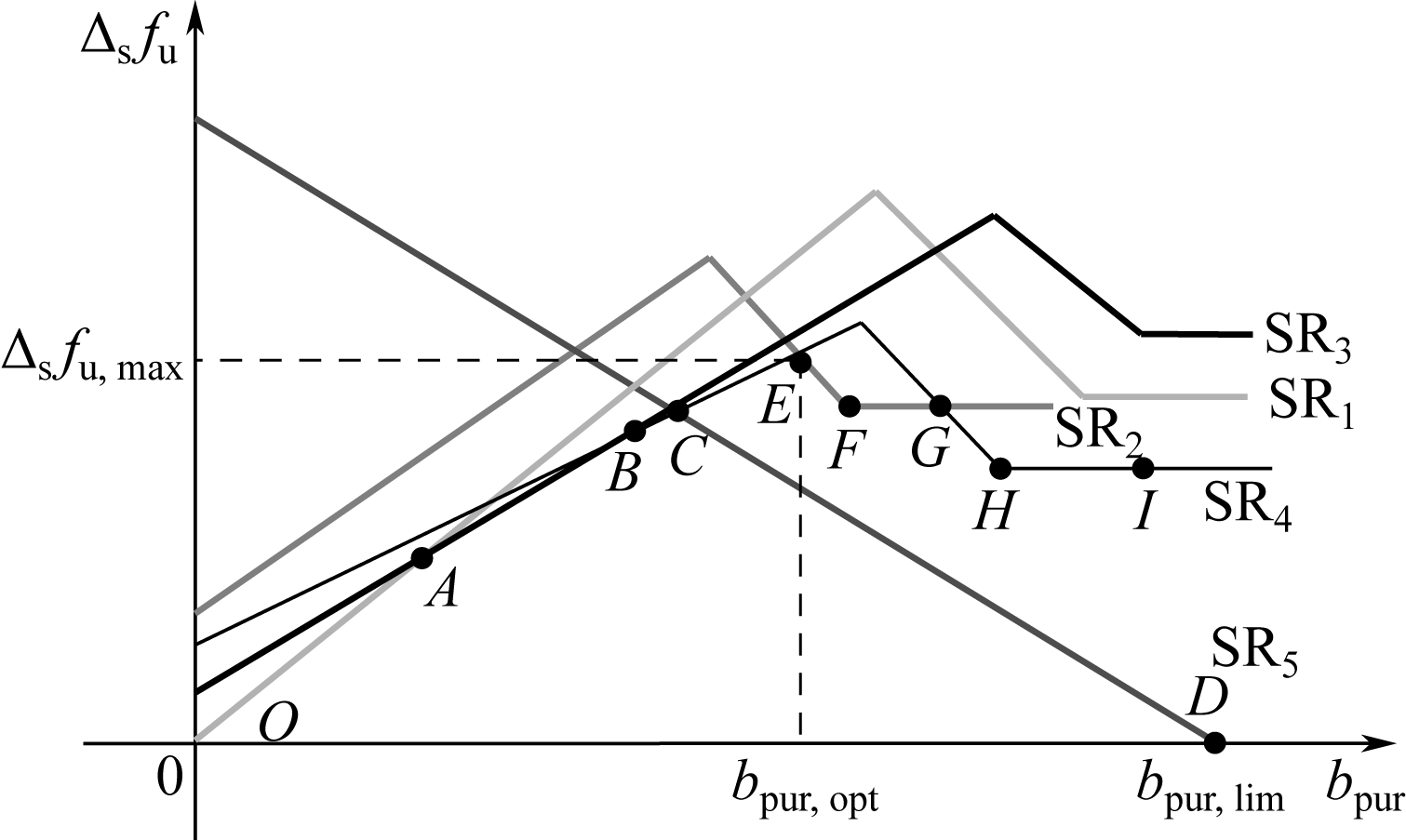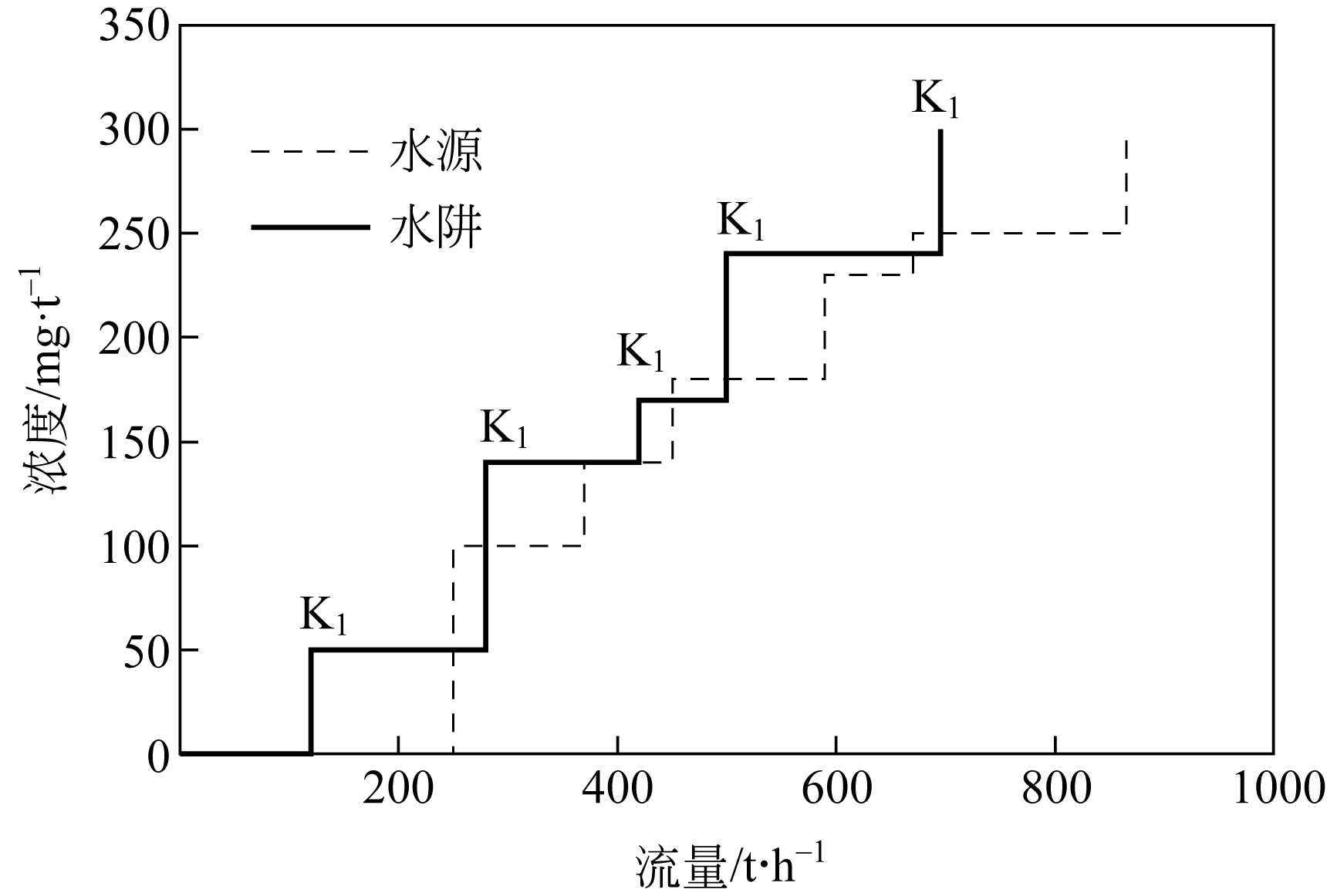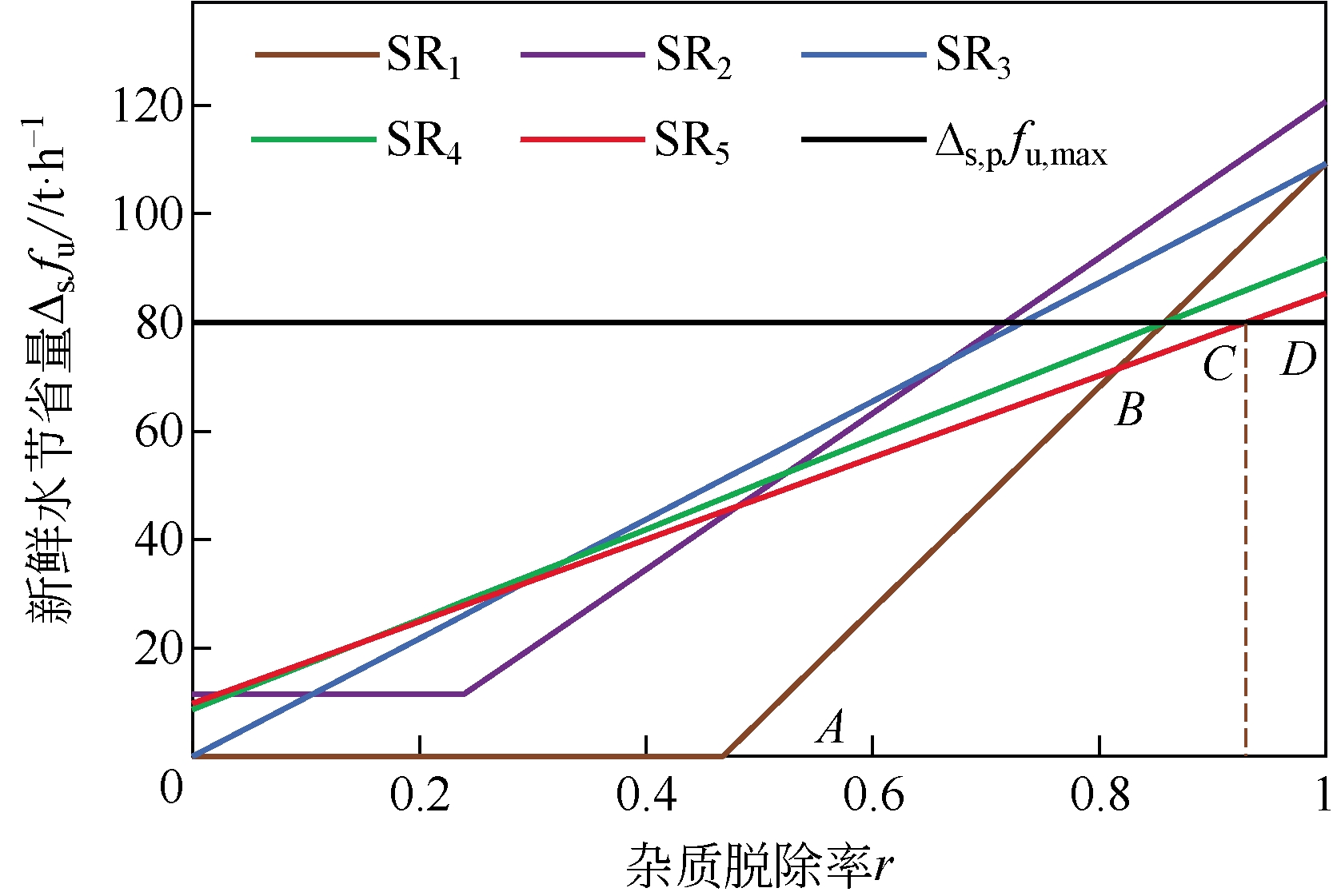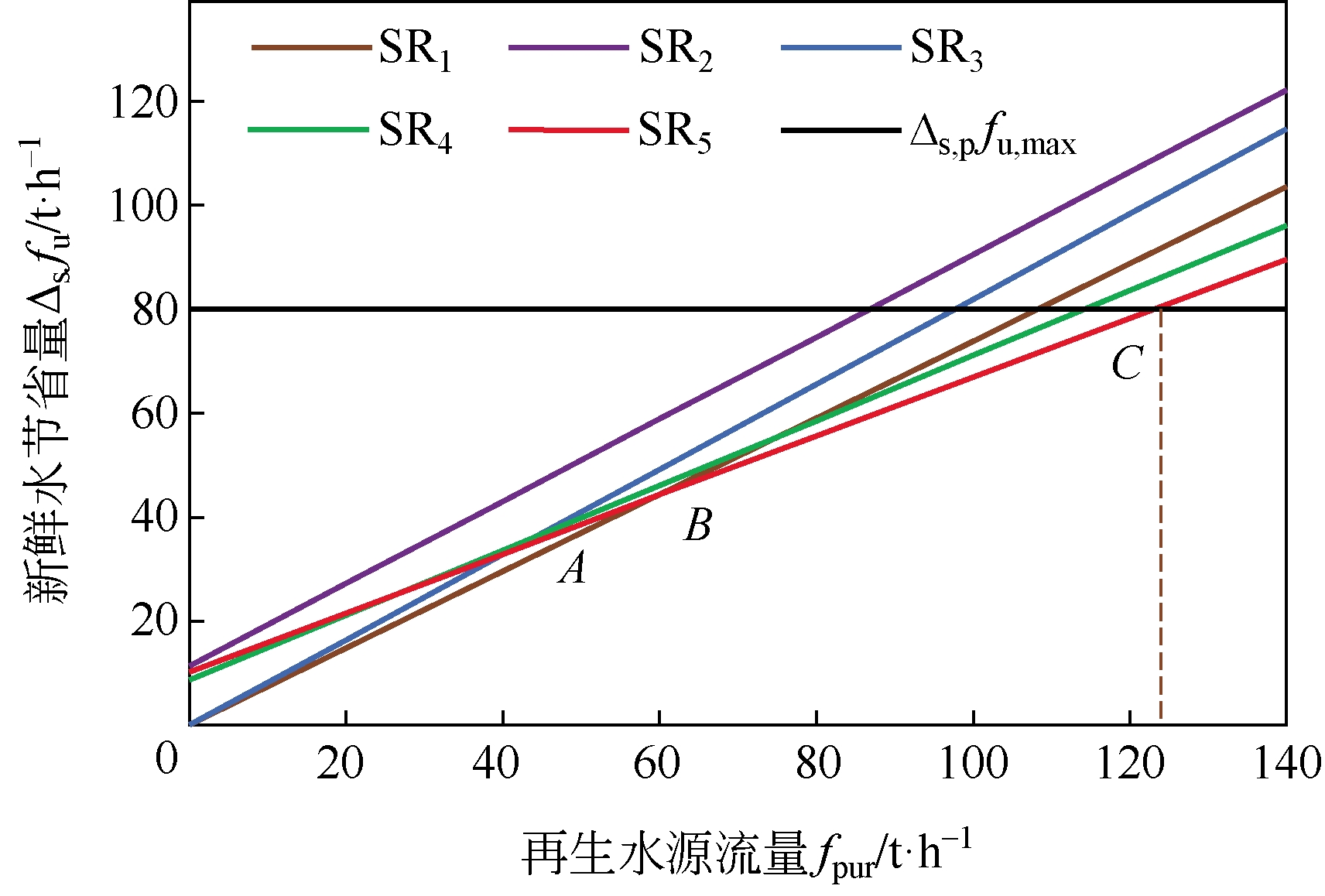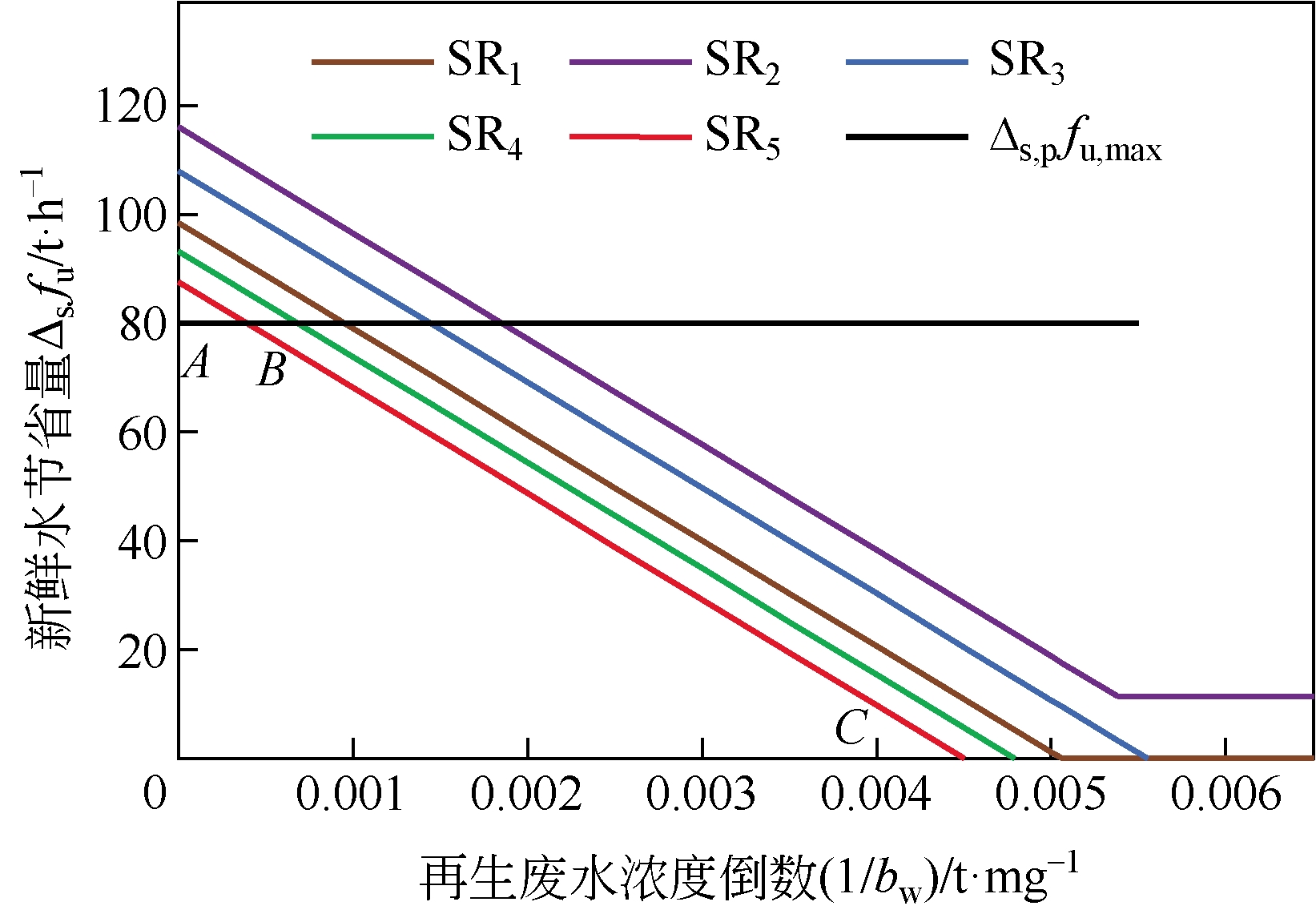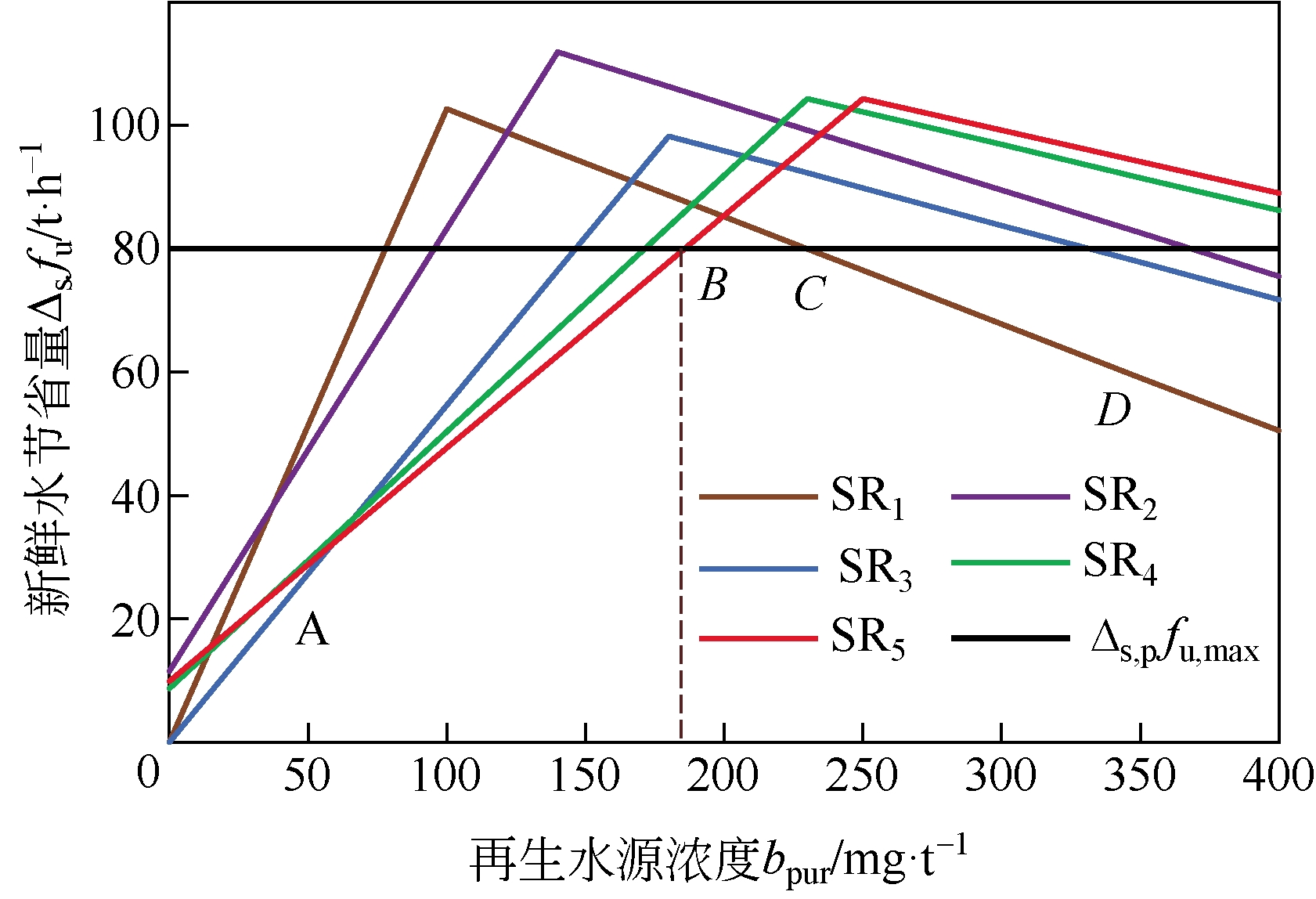Chemical Industry and Engineering Progress ›› 2019, Vol. 38 ›› Issue (04): 1671-1680.DOI: 10.16085/j.issn.1000-6613.2018-1318
• Chemical processes and equipment • Previous Articles Next Articles
Impurity-deficit based graphical method for integrating water network with regeneration reuse
- School of Chemical Engineering and Technology, Xi’an Jiaotong University, Xi’an 710049, Shaanxi, China
-
Received:2018-06-26Revised:2018-10-09Online:2019-04-05Published:2019-04-05 -
Contact:LIU Guilian
基于杂质赤字的再生回用水网络集成图示法
- 西安交通大学化学工程与技术学院,陕西 西安 710049
-
通讯作者:刘桂莲 -
作者简介:<named-content content-type="corresp-name">吕东晖</named-content>(1995—),男,硕士研究生,研究方向为系统工程。E-mail:<email>814929751@qq.com</email>。|刘桂莲,教授,博士生导师,研究方向为系统工程。E-mail:<email>guilianliui@mail.xjtu.edu.cn</email>。 -
基金资助:国家自然科学基金(U1662126,21476180)
CLC Number:
Cite this article
LÜ Donghui, LIU Guilian. Impurity-deficit based graphical method for integrating water network with regeneration reuse[J]. Chemical Industry and Engineering Progress, 2019, 38(04): 1671-1680.
吕东晖, 刘桂莲. 基于杂质赤字的再生回用水网络集成图示法[J]. 化工进展, 2019, 38(04): 1671-1680.
share this article
Add to citation manager EndNote|Ris|BibTeX
URL: https://hgjz.cip.com.cn/EN/10.16085/j.issn.1000-6613.2018-1318
| 流股 | 流量f/ t·h-1 | b in,max/mg·t-1 | b out,max/mg·t-1 |
|---|---|---|---|
| 1 | 120 | 0 | 100 |
| 2 | 80 | 50 | 140 |
| 3 | 80 | 50 | - |
| 4 | 140 | 140 | 180 |
| 5 | 80 | 170 | 230 |
| 6 | 195 | 240 | 250 |
| 流股 | 流量f/ t·h-1 | b in,max/mg·t-1 | b out,max/mg·t-1 |
|---|---|---|---|
| 1 | 120 | 0 | 100 |
| 2 | 80 | 50 | 140 |
| 3 | 80 | 50 | - |
| 4 | 140 | 140 | 180 |
| 5 | 80 | 170 | 230 |
| 6 | 195 | 240 | 250 |
| 水源 | 浓度/mg·t-1 | 流量/t·h-1 | 水阱 | 浓度/mg·t-1 | 流量/t·h-1 |
|---|---|---|---|---|---|
| SR0 | 0 | 250 | SK1 | 0 | 120 |
| SR1 | 100 | 120 | SK2 | 50 | 80 |
| SR2 | 140 | 80 | SK3 | 50 | 80 |
| SR3 | 180 | 140 | SK4 | 140 | 140 |
| SR4 | 230 | 80 | SK5 | 170 | 80 |
| SR5 | 250 | 195 | SK6 | 240 | 195 |
| 水源 | 浓度/mg·t-1 | 流量/t·h-1 | 水阱 | 浓度/mg·t-1 | 流量/t·h-1 |
|---|---|---|---|---|---|
| SR0 | 0 | 250 | SK1 | 0 | 120 |
| SR1 | 100 | 120 | SK2 | 50 | 80 |
| SR2 | 140 | 80 | SK3 | 50 | 80 |
| SR3 | 180 | 140 | SK4 | 140 | 140 |
| SR4 | 230 | 80 | SK5 | 170 | 80 |
| SR5 | 250 | 195 | SK6 | 240 | 195 |
| b g | —— | 再生产品的浓度,mg/t |
| bi | —— | 任一指定水源的浓度,mg/t |
| bi * | —— | 与水阱连接线i相交的水源的杂质浓度,mg/t |
| b in,max | —— | 水阱最大进口杂质浓度,mg/t |
| b out,max | —— | 水阱最大出口杂质浓度,mg/t |
| b pin * | —— | 再生后为新夹点杂质浓度,mg/t |
| b pur | —— | 再生水源的浓度,mg/t |
| b pur0 | —— | 再生水源之下的水源位置发生跃迁时的再生水源浓度,mg/t |
| b pur,lim | —— | 极限再生水源浓度,mg/t |
| b pur,opt | —— | 最优再生水源浓度,mg/t |
| b u | —— | 新鲜水源杂质浓度,mg/t |
| b w | —— | 再生废水杂质浓度,mg/t |
| b w0 | —— | 再生水源之下的水源位置发生跃迁时的再生废水浓度,mg/t |
| b w,lim | —— | 极限再生废水浓度,mg/L |
| c g | —— | 提纯产品的氢的摩尔分数,% |
| ci * | —— | 与水阱连接线i相交的氢源摩尔分数,% |
| c pin * | —— | 提纯后为新夹点的氢源摩尔分数,% |
| c pur | —— | 提纯氢源的摩尔分数,% |
| c u | —— | 氢公用工程摩尔分数,% |
| F pur | —— | 提纯氢源流量,mol/s |
| f | —— | 水源或水阱的流量,t/h |
| f g | —— | 再生产品的流量,t/h |
| f pur | —— | 再生水源的流量,t/h |
| f pur,lim | —— | 极限再生水源的流量,t/h |
| f pur,opt | —— | 最优再生水源的流量,t/h |
| f u 0 | —— | 为初始状态时的新鲜水量,t/h |
| f u ′ | —— | 夹点出现时水网络的新鲜水消耗量,t/h |
| f w | —— | 再生废水的流量,t/h |
| Hi | —— | 氢阱连接线i处的累积剩余氢量,mol/s |
| hi | —— | 水阱连接线i累积杂质赤字,mg/h |
| R | —— | 纯氢收率 |
| r | —— | 杂质脱除率 |
| r 0 | —— | 再生水源之下的水源位置发生跃迁时的杂质脱除率 |
| r lim,max | —— | 最大杂质脱除率 |
| r lim,min | —— | 最小杂质脱除率 |
| r opt | —— | 最优杂质脱除率 |
| SK j | —— | 水阱j |
| SR i | —— | 水源i |
| ?F u ,i | —— | 未考虑提纯的氢网络中某氢阱连接线的公用工程迁量,mol/s |
| ?F u * | —— | 未考虑提纯的氢网络确保夹点形成的公用工程迁量,mol/s |
| ?s F u, i | —— | 提纯后的公用工程节省量,mol/s |
| ?f u, i | —— | 未考虑再生的水网络中某水阱连接线的新鲜水迁量,t/h |
| ?f u * | —— | 未考虑再生的水网络确保夹点形成的新鲜水迁量,t/h |
| ?s f u ,i | —— | 考虑再生的水网络某水阱连接线的新鲜水节省量,t/h |
| ?s f u,ma x | —— | 水网络系统最大的新鲜水节省量,t/h |
| ?s,p f u,max | —— | 再生产品之下的水源确定的最大新鲜水节省量,t/h |
| b g | —— | 再生产品的浓度,mg/t |
| bi | —— | 任一指定水源的浓度,mg/t |
| bi * | —— | 与水阱连接线i相交的水源的杂质浓度,mg/t |
| b in,max | —— | 水阱最大进口杂质浓度,mg/t |
| b out,max | —— | 水阱最大出口杂质浓度,mg/t |
| b pin * | —— | 再生后为新夹点杂质浓度,mg/t |
| b pur | —— | 再生水源的浓度,mg/t |
| b pur0 | —— | 再生水源之下的水源位置发生跃迁时的再生水源浓度,mg/t |
| b pur,lim | —— | 极限再生水源浓度,mg/t |
| b pur,opt | —— | 最优再生水源浓度,mg/t |
| b u | —— | 新鲜水源杂质浓度,mg/t |
| b w | —— | 再生废水杂质浓度,mg/t |
| b w0 | —— | 再生水源之下的水源位置发生跃迁时的再生废水浓度,mg/t |
| b w,lim | —— | 极限再生废水浓度,mg/L |
| c g | —— | 提纯产品的氢的摩尔分数,% |
| ci * | —— | 与水阱连接线i相交的氢源摩尔分数,% |
| c pin * | —— | 提纯后为新夹点的氢源摩尔分数,% |
| c pur | —— | 提纯氢源的摩尔分数,% |
| c u | —— | 氢公用工程摩尔分数,% |
| F pur | —— | 提纯氢源流量,mol/s |
| f | —— | 水源或水阱的流量,t/h |
| f g | —— | 再生产品的流量,t/h |
| f pur | —— | 再生水源的流量,t/h |
| f pur,lim | —— | 极限再生水源的流量,t/h |
| f pur,opt | —— | 最优再生水源的流量,t/h |
| f u 0 | —— | 为初始状态时的新鲜水量,t/h |
| f u ′ | —— | 夹点出现时水网络的新鲜水消耗量,t/h |
| f w | —— | 再生废水的流量,t/h |
| Hi | —— | 氢阱连接线i处的累积剩余氢量,mol/s |
| hi | —— | 水阱连接线i累积杂质赤字,mg/h |
| R | —— | 纯氢收率 |
| r | —— | 杂质脱除率 |
| r 0 | —— | 再生水源之下的水源位置发生跃迁时的杂质脱除率 |
| r lim,max | —— | 最大杂质脱除率 |
| r lim,min | —— | 最小杂质脱除率 |
| r opt | —— | 最优杂质脱除率 |
| SK j | —— | 水阱j |
| SR i | —— | 水源i |
| ?F u ,i | —— | 未考虑提纯的氢网络中某氢阱连接线的公用工程迁量,mol/s |
| ?F u * | —— | 未考虑提纯的氢网络确保夹点形成的公用工程迁量,mol/s |
| ?s F u, i | —— | 提纯后的公用工程节省量,mol/s |
| ?f u, i | —— | 未考虑再生的水网络中某水阱连接线的新鲜水迁量,t/h |
| ?f u * | —— | 未考虑再生的水网络确保夹点形成的新鲜水迁量,t/h |
| ?s f u ,i | —— | 考虑再生的水网络某水阱连接线的新鲜水节省量,t/h |
| ?s f u,ma x | —— | 水网络系统最大的新鲜水节省量,t/h |
| ?s,p f u,max | —— | 再生产品之下的水源确定的最大新鲜水节省量,t/h |
| 1 | 杨友麒, 庄芹仙 . 炼油化工企业节水减排的进展和存在问题[J]. 化工进展, 2012, 31(12): 2780-2785. |
| YANG Y Y , ZHUANG Q X . Water conservation and waste water reduction of chemical and refinery enterprises: progresses and problems[J]. Chemical Industry and Engineering Progress, 2012, 31(12): 2780-2785. | |
| 2 | 周枫, 徐宏勇, 蔡兰坤 . 基于数学优化算法的多杂质用水网络优化综述[J]. 工业水处理, 2014(6): 10-13. |
| ZHOU F , XU H Y , CAI L K .Review of the mathematical optimization algorithms for water networks with polymictic impurity[J]. Industrial Water Treatment, 2014(6): 10-13. | |
| 3 | 白洁,冯霄 . 水系统集成方法分析[J]. 化工进展,2006,25(12): 1471-1477. |
| BAI J , FENG X . Analysis of technologies for water system integration[J]. Chemical Industry and Engineering Progress, 2006, 25(12): 1471-1477. | |
| 4 | TAKAMA N , KURIYAMA T , SHIROKO K ,et al . Optimal water allocation in a petroleum refinery[J]. Computers and Chemical Engineering,1980,4(4): 251-258. |
| 5 | 程华农, 孙杰, 毛文锋, 等 . 单杂质间歇过程用水网络优化[J]. 化工进展, 2007, 26(2): 267-270. |
| CHENG H N , SUN J , MAI W F, et al .Water-using network optimization for batch processes with a single contaminant[J]. Chemical Industry and Engineering Progress, 2007, 26(2): 267-270. | |
| 6 | MAJOZI T . Wastewater minimisation using central reusable water storage in batch plants[J]. Computers & Chemical Engineering, 2005, 29(7): 1631-1646. |
| 7 | HALLALE N . A new graphical targeting method for water minimisation[J]. Advances in Environmental Research, 2002, 6(2002): 377-390. |
| 8 | FOO D C Y . A generalised guideline for process changes for resource conservation;networks[J]. Clean Technologies & Environmental Policy, 2013, 15(1): 45-53. |
| 9 | FENG X , CHU K H . Cost optimization of industrial wastewater reuse systems[J]. Process Safety & Environmental Protection, 2004, 82(3): 249-255. |
| 10 | FENG X , BAI J , WANG H , et al . Grass-roots design of regeneration recycling water networks[J]. Computers & Chemical Engineering, 2008, 32(8): 1892-1907. |
| 11 | BAI J , FENG X , DENG C . Optimal design of single-contaminant regeneration reuse water networks with process decomposition[J]. AIChE Journal, 2010, 56(4): 915-929. |
| 12 | LIU Z Y , Yang Y , WAN L Z , et al . A heuristic design procedure for water-using networks with multiple contaminants[J]. AIChE Journal, 2009, 55(2): 374-382. |
| 13 | LIU Z Y , LI Y M , LIU Z H , et al . A simple method for design of water-using networks with multiple contaminants involving regeneration reuse[J]. AIChE Journal, 2010, 55(6): 1628-1633. |
| 14 | CHATURVEDI N D , MANAN Z A , ALWI S R W , et al . Effect of multiple water resources in a flexible-schedule batch water network[J]. Journal of Cleaner Production, 2016, 125(14): 245-252. |
| 15 | ZHANG K , ZHAO Y , CAO H , et al . Optimization of the water network with single and double outlet treatment units[J]. Industrial & Engineering Chemistry Research, 2017, 56(10): 2865-2871. |
| 16 | DENG C , FENG X . Targeting for conventional and property-based water network with multiple resources[J]. Industrial & Engineering Chemistry Research, 2011, 50(7): 3722-3737. |
| 17 | DENG C , FENG X , NG D K S, et al . Process-based graphical approach for simultaneous targeting and design of water network[J]. AIChE Journal, 2011, 57(11): 3085-3104. |
| 18 | 史春峰, 邓春, 冯霄 . 具有双出口再生单元再生循环水网络的优化[J]. 化工进展, 2014, 33(3): 605-610. |
| SHI C F , DENG C , FENG X . Optimization of regeneration recycling water networks with double outlets regeneration units[J]. Chemical Industry and Engineering Progress, 2014, 33(3): 605-610. | |
| 19 | 史春峰, 邓春, 冯霄 . 具有多个双出口再生单元的再生循环水网络优化[J]. 计算机与应用化学, 2015, 32(5): 545-550. |
| SHI C F , DENG C , FENG X . Optimization of regeneration recycling water networks with mutiple double outlets regeneration units [J].Computers and Applied Chemistry, 2015, 32(5): 545-550. | |
| 20 | 邓春, 史春峰, 陈杰, 等 . 耦合多个废水处理过程的再生再利用水网络优化设计[J]. 计算机与应用化学, 2016, 33(3): 313-319. |
| DENG C , SHI C F , CHEN J , et al . Optimal design of regeneration reutilization water network coupled with multiple wastewater treatment processes[J]. Computers and Applied Chemistry, 2016, 33(3): 313-319. | |
| 21 | 周文晋, 江苇, 邓春, 等 . 工业多水源供水网络优化设计[J]. 化工学报, 2018, 69(6): 2560-2566. |
| ZHOU W J , JIANG W , DENG C , et al . Optimum design of industrial water supply network with multiple resources[J]. CIESC Journal, 2018, 69(6): 2560-2566. | |
| 22 | 陈晓露, 常承林, 王彧斐, 等 . 考虑再生循环的多杂质用水网络全局优化[J]. 化工进展, 2017, 36(6): 2064-2069. |
| CHEN X L , CHANG C L , WANH Y F , et al . Global optimization for multi-contaminant water networks with regeneration recycling unit[J]. Chemical Industry and Engineering Progress, 2017, 36(6): 2064-2069. | |
| 23 | 陈雁玲, 刘琳琳, 何湛聪,等 . 考虑再生操作的间歇过程用水网络优化[J]. 化工进展, 2017, 36(4): 1173-1179. |
| CHEN Y L , LIU L L , HE Z C , et al . Optimization of water-using network in batch processes involving regeneration operation[J]. Chemical Industry and Engineering Progress, 2017, 36(4):1173-1179. | |
| 24 | 宋华超, 张桥 . 多杂质氢网络、水网络的统一数学规划优化法[J]. 计算机与应用化学, 2017, 34(4): 311-316. |
| SONG H C , ZHANG Q . Unified mathematical optimization method for both hydrogen and water networks with multiple contaminants[J]. Computers and Applied Chemistry, 2017, 34(4): 311-316. | |
| 25 | LIU G , LI H , FENG X , et al . A conceptual method for targeting the maximum purification feed flow rate of hydrogen network[J]. Chemical Engineering Science, 2013, 88(12): 33-47. |
| 26 | LIU G , LI H , FENG X , et al . Novel method for targeting the optimal purification feed flow rate of hydrogen network with purification reuse/recycle[J]. AIChE Journal, 2013, 59(6): 1964-1980. |
| 27 | LIU G , ZHENG M , LI L , et al . Effect of purification feed and product purities on the hydrogen network integration[J]. Industrial & Engineering Chemistry Research, 2014, 53(15): 6433–6449. |
| 28 | DAI W , SHEN R , ZHANG D , et al . The integration based method for identifying the variation trend of fresh hydrogen consumption and optimal purification feed [J]. Energy, 2017, 119: 732-743. |
| [1] | LI Mengyuan, GUO Fan, LI Qunsheng. Simulation and optimization of the third and fourth distillation columns in the recovery section of polyvinyl alcohol production [J]. Chemical Industry and Engineering Progress, 2023, 42(S1): 113-123. |
| [2] | ZHANG Ruijie, LIU Zhilin, WANG Junwen, ZHANG Wei, HAN Deqiu, LI Ting, ZOU Xiong. On-line dynamic simulation and optimization of water-cooled cascade refrigeration system [J]. Chemical Industry and Engineering Progress, 2023, 42(S1): 124-132. |
| [3] | WANG Fu'an. Consumption and emission reduction of the reactor of 300kt/a propylene oxide process [J]. Chemical Industry and Engineering Progress, 2023, 42(S1): 213-218. |
| [4] | WANG Zhengkun, LI Sifang. Green synthesis of gemini surfactant decyne diol [J]. Chemical Industry and Engineering Progress, 2023, 42(S1): 400-410. |
| [5] | LI Chunli, HAN Xiaoguang, LIU Jiapeng, WANG Yatao, WANG Chenxi, WANG Honghai, PENG Sheng. Research progress of liquid distributors in packed columns [J]. Chemical Industry and Engineering Progress, 2023, 42(9): 4479-4495. |
| [6] | QIAO Xu, ZHANG Zhuxiu. Consideration and exploration of the development path for inherent safety of chemical engineering [J]. Chemical Industry and Engineering Progress, 2023, 42(7): 3319-3324. |
| [7] | LIN Hai, WANG Yufei. Distributed wind farm layout optimization considering noise constraint [J]. Chemical Industry and Engineering Progress, 2023, 42(7): 3394-3403. |
| [8] | XUE Kai, WANG Shuai, MA Jinpeng, HU Xiaoyang, CHONG Daotong, WANG Jinshi, YAN Junjie. Planning and dispatch of distributed integrated energy systems for industrial parks [J]. Chemical Industry and Engineering Progress, 2023, 42(7): 3510-3519. |
| [9] | LI Haidong, YANG Yuankun, GUO Shushu, WANG Benjin, YUE Tingting, FU Kaibin, WANG Zhe, HE Shouqin, YAO Jun, CHEN Shu. Effect of carbonization and calcination temperature on As(Ⅲ) removal performance of plant-based Fe-C microelectrolytic materials [J]. Chemical Industry and Engineering Progress, 2023, 42(7): 3652-3663. |
| [10] | GU Shiya, DONG Yachao, LIU Linlin, ZHANG Lei, ZHUANG Yu, DU Jian. Design and optimization of pipeline system for carbon capture considering intermediate nodes [J]. Chemical Industry and Engineering Progress, 2023, 42(6): 2799-2808. |
| [11] | HOU Dianbao, HE Maoyong, CHEN Yugang, YANG Haiyun, LI Haimin. Application analysis of resource allocation optimization and circular economy in development and utilization of potassium resources [J]. Chemical Industry and Engineering Progress, 2023, 42(6): 3197-3208. |
| [12] | ZHU Hao, LIU Hanfei, GAO Yuan, BAI Rongrong, NI Songbo, HUANG Yiping, LI Qingtong, LI Xiaodong, HAN Weiqing. Parameter optimization of jet aeration in catalytic ozonation system and analysis of stage oxidation of phenol [J]. Chemical Industry and Engineering Progress, 2023, 42(5): 2717-2723. |
| [13] | LING Shan, LIU Juming, ZHANG Qiancheng, LI Yan. Research progress on simulated moving bed separation process and its optimization methods [J]. Chemical Industry and Engineering Progress, 2023, 42(5): 2233-2244. |
| [14] | WANG Dong, YU Pinhua, CHEN Bin, XIAO Ang, CHEN Feng, JIANG Yangyang. Energy saving optimization of cyclohexane three-effect distillation in cyclohexanone production [J]. Chemical Industry and Engineering Progress, 2023, 42(5): 2245-2251. |
| [15] | MA Runmei, YANG Haichao, LI Zhengda, LI Shuangxi, ZHAO Xiang, ZHANG Guoqing. Influence analysis of coating on deformation and frictional wear of mechanical seal end for high-speed bearing cavity [J]. Chemical Industry and Engineering Progress, 2023, 42(4): 1688-1697. |
| Viewed | ||||||
|
Full text |
|
|||||
|
Abstract |
|
|||||

